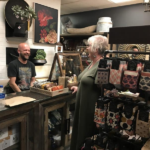How to get customers in the door of small town and rural retail stores
If you have a retail store in a small town, you know how difficult it can be to attract customers in the door. With so much online competition and limited resources, it is hard to get people in the store and buying your products. In this article, we’ll share some of our best ways […]
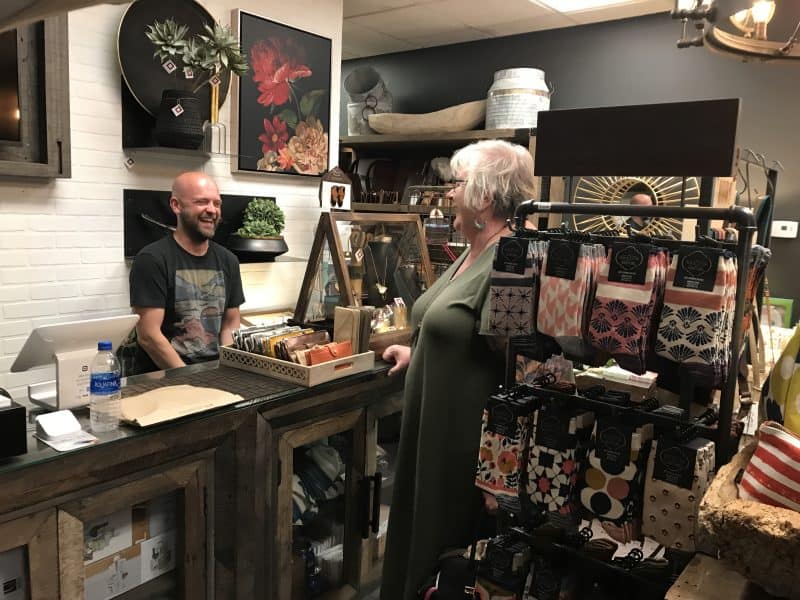
Having trouble getting customers in the door? Consider these tips. Photo by Becky McCray
If you have a retail store in a small town, you know how difficult it can be to attract customers in the door. With so much online competition and limited resources, it is hard to get people in the store and buying your products. In this article, we’ll share some of our best ways to get customers in the door of your retail store.
In our recent Survey of Rural Challenges, one store owner said, “Our challenge is getting customers in the door. They assume the selection and prices will be better at big box stores. If we can get people into the store they see that we have better quality at better prices, and we get the sale.”
Another said even bribery wasn’t working: “People who live in town have never walked through the door. Even when I sent them a $20 gift card to entice them.”
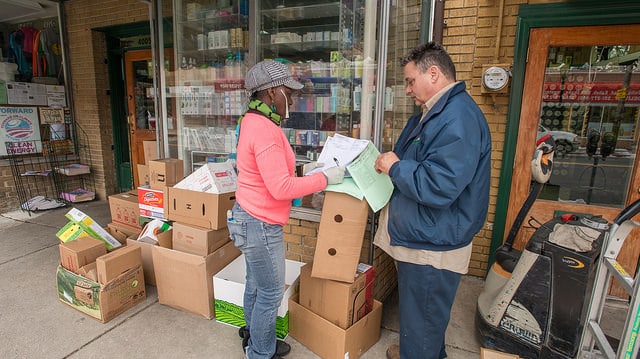
Check your store’s product selection. Is it what people really want these days? Photo by USDA
Do you have what they really want?
Make sure you have what your customers want. All the promotion in the world won’t drive customers to a business that doesn’t offer what people want.
The first retailer above said if customers do come in, “we get the sale.” That’s a good indication that you’re on target.
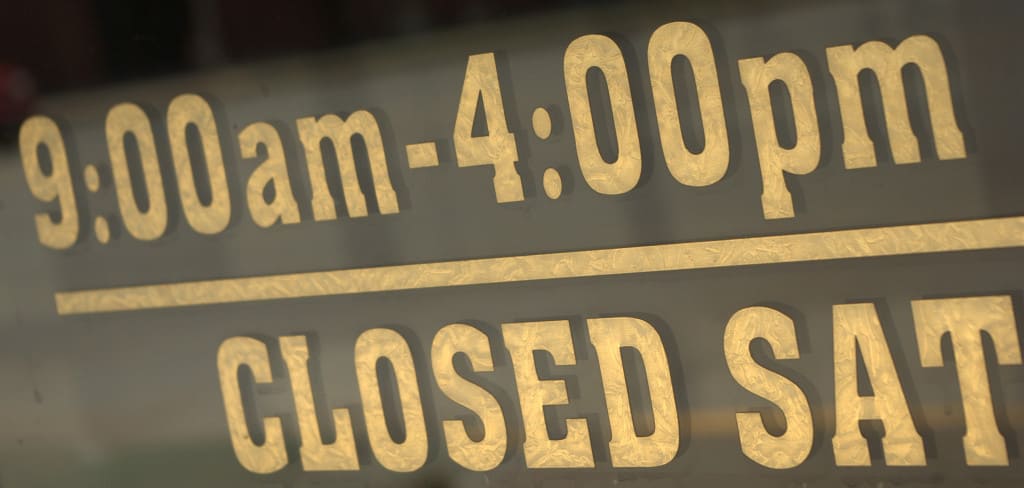
Limited business hours are the Number One complaint against small town businesses. Most of us don’t live on this schedule any more. Photo by Becky McCray.
Are you open when they’re shopping?
They can’t come in the door, if the door isn’t open.
Bob Phibbs, The Retail Doctor, made a house call with us some time ago to talk through small town retail challenges. Here’s his advice about hours:
“Studies have shown that, in order, these are the best money making times for retail:
- Saturday 11 am – 1 pm
- Saturday 3 pm – 5 pm
- Sunday 3 pm – 5 pm
- Sunday 11 am – 1 pm
“If your store is closed on Sundays, you may be missing out on two of the top four money-making times! You have to test these against your store to see if it proves true.”
I ran a retail store for almost 13 years in a small town. We were open 10am to 9pm, Monday through Saturday. Sales from 5-9pm were always more than sales from 10am to 5pm. Almost every single day for over 4000 days, evenings beat day time for us.
If you’re willing to do some simple research, you can find out the best hours for a store in your town.

You have a lot of marketing tools at hand today. Use them to remind people over and over that your store is here and what you offer.
Invite them in again and again, at least 13 times
Our contributor Glenn Muske said, “Research has found that potential customers need to hear or see the name of a new business three to five times before they even recognize that the business exists. Thus, a one-time big advertisement will do little to bring in customers. Continuity in the early days is crucial.
“Knowing about the business is only part of step one, however. You now have to get customers in the door. Research suggests that potential customers may need another five to seven contacts with your product or service to recognize its benefits to them. Remember, the customer wants to solve a problem.”
Contacts with your customers can be all the times they see your ads, social media posts, flyers, online listings, signs or sponsorship of local causes. You don’t get to count the ones they don’t see.
You have to put your business out there a lot more than you think in order to get just one customer in the door.
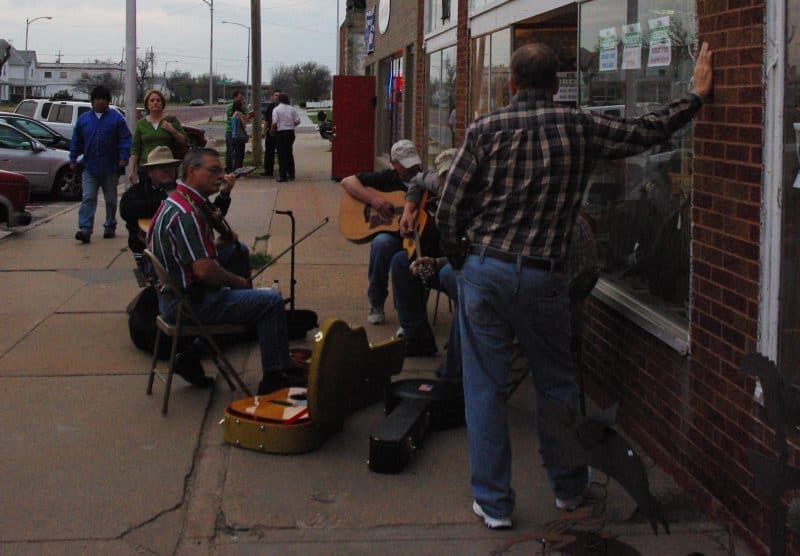
Musicians on the sidewalk? Tool days in the parking lot? Dinner in the greenhouse? There’s no end to the experiences you can create in or outside your store that help you bring people in the doors. Photo by Becky McCray.
Create experiences with events
To survive in independent local retail today, you must provide an experience that can’t be duplicated by chain stores or online or in the big city. Events are one of the best ways to create a meaningful experience that is tough for any big store to duplicate.
Hold an event that is a real experience
The owner of a retail hardware store and greenhouse in rural Kansas started brainstorming ideas for events he could hold to create an experience for customers.
- Tool Days. Bring in the guy who does blade sharpening for the afternoon. Set up tents in the parking lot and have people teach how you use tools of all kinds. Do demonstrations and hands-on (appropriate) play with tools.
- Dinner in the Greenhouse. His well-stocked greenhouse is a wonderfully green and lush space in dry Western Kansas. There’s room for a couple of tables, and there’s a bubbling fountain. It’s great! Let’s have dinner there! Get a local eatery or aspiring chef to cater. Have fun with it. Use a jungle theme. Get creative. Since there are only a couple of tables available, turn it into a super-exclusive special thing that not everyone can do. Sell out early.
Do a bunch of mini-events
I’ve shared these ideas for mini-events for rural retail businesses before:
- Recruit anyone who gives lessons to hold a student performance (could be music, dance, martial arts, drama, writing, language, anything!) Students bring families, instant crowd
- Bring games, tables and chairs and hold a game night (board games, card games, dominoes, adult coloring books, you name it)
- Bring beach chairs and umbrellas and pretend you have a downtown beach (play beachy summer music for bonus points)
- Hold a tasting or sampling from any local winery, food business, or even cooking classes
- Read poetry or start community conversations on any topic you like (poetry slam?)

A local furniture store hosts two temporary businesses for a special shopping event, combining business-in-a-business and pop-ups to benefit everyone. Photo by Becky McCray.
Host a pop-up business inside your business
Invite another business to set up in a corner of your shop, as a pop up. This could be an artist, artisan, maker, crafter or tinkerer.
Look for those that are doing business from their homes. Maybe they are just beginning to think about making some money with their products or are just starting to get an online following.
Once they setup, make more of it:
- Hold a meet the artist event
- Have a party announcing your new acquisition
- Create a Facebook event and do something special to announce their arrival
Joann Schissel shared her pop-up event success story with me:
“My partner and I have a winery business (Nearwood Winery). He makes the wine, and I’m in charge of customer experience. We have a small tasting room on the square in Knoxville. We’ve found that pop-up shops or a one-time event seems to bring in customers. Our next community event is “Living Windows” which kicks off the holiday shopping season. We invited a crafter to set up her “shop” inside our wine tasting room for that evening. She sells hand made gift bags that hold a bottle of wine. Other pop ups we’ve had is book signings by local authors and art exhibits by local artists. All these type of promos seem to bring in customers. We try to focus on products/services that enhance the wine experience. Our motto is “where creatives gather.”
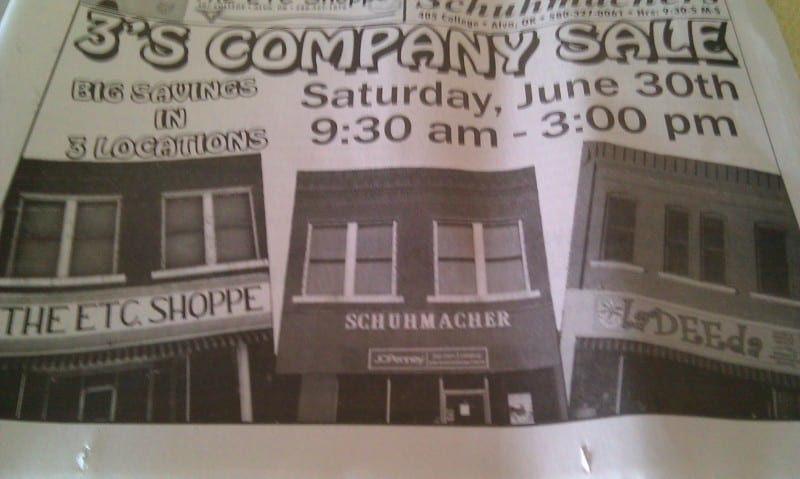
Three local stores cooperated on this joint ad, marketing their stores together. Photo by Becky McCray.
Cooperate with other businesses
Leverage your relationships with other businesses to put together a tour of businesses, or an experience that includes more than just your business.
Joann did this, too! She created a local fashion show:
“I reached out to our business owners that had fashions or a tangent business. I know a jewelry designer that will match her product with the clothes from the boutiques. A local photographer will take photos of the models and the event. A fabric designer that makes her own jackets will model her creations.
“I charged $5 advance tickets (available online or at the shops) and $10 at the door. The first beverage is free, so there is very little ‘risk’ to the guests, but allows me to gauge interest and attendance. We had 15 models (includes kids) and friends/relatives were in the audience. I am focused on ‘gathering my crowd’ strategy and catering to established groups of people that have their own crowd. I loved working with the women business owners and promoting their products.”
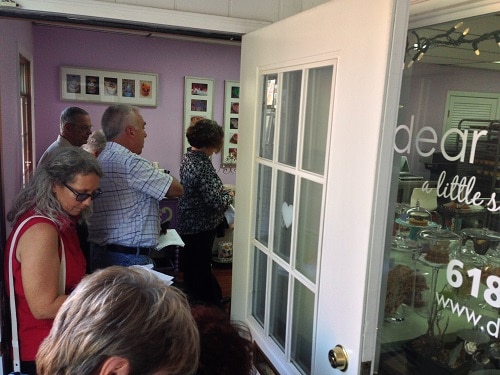
The retail store owner’s dream: so many customers, they can’t all get in the doors at once! Photo by Becky McCray
Keep trying and keep trying
After more than a dozen years of small town retail experience, I understand how it feels to stand in an empty store and wonder where all the customers went. But today, we have so many tools to market our businesses, serve customers in new ways, and create experiences they can’t get anywhere else. Our best bet for survival is to keep trying new experiments and keep the ones that work best. Then try more new experiments.
Subscribe to SmallBizSurvival.com
